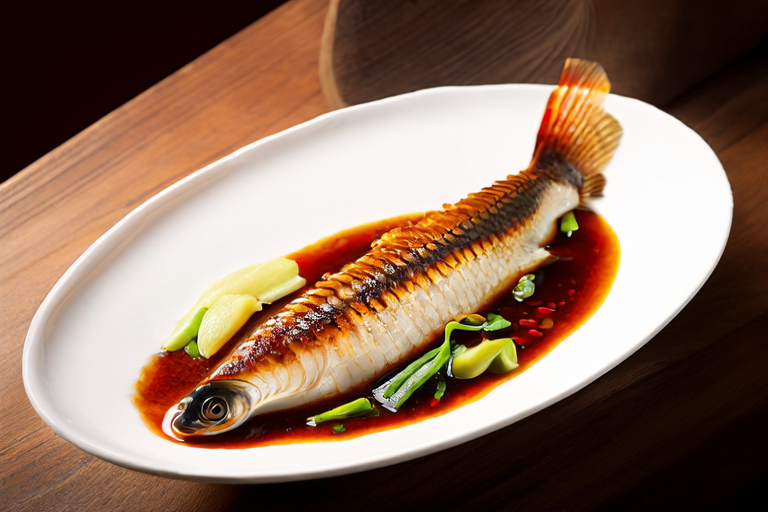Exploring the Delicacies of Anhui: Braised Mandarin Fish with Vegetables
Welcome to our culinary journey through the rich and diverse world of Anhui cuisine. In this article, we will delve into one of the most celebrated dishes from this region: Braised Mandarin Fish with Vegetables. This dish not only showcases the exquisite balance of flavors that Anhui cuisine is renowned for but also highlights the importance of seasonal ingredients and traditional cooking techniques.
Introduction to Anhui Cuisine
Anhui cuisine, also known as Hui cuisine, is one of the eight major cuisines of China. It originated in the Huangshan Mountains area and is characterized by its use of wild herbs and fungi, along with a preference for braising and stewing methods. The cuisine is deeply rooted in the local geography and culture, making it both unique and reflective of the natural bounty of the region. Among its many specialties, Braised Mandarin Fish with Vegetables stands out as a testament to the harmonious blend of simplicity and sophistication.
The Ingredients
- Fresh Mandarin Fish: This dish primarily features the mandarin fish, a freshwater fish native to the Yangtze River basin. Known for its tender texture and mild flavor, the fish is the star of this dish.
- Vegetables: Typically, vegetables such as bamboo shoots, mushrooms, and green onions are used to complement the fish. These vegetables are carefully selected for their freshness and ability to enhance the overall taste of the dish.
- Soy Sauce and Rice Wine: These are essential seasonings that provide depth and complexity to the dish. Soy sauce adds umami, while rice wine contributes a subtle sweetness.
- Ginger and Garlic: These aromatics are crucial for infusing the dish with a fragrant base.
- Seasonal Herbs: Depending on the time of year, various herbs like chives or cilantro may be added to elevate the dish’s flavor profile.
Preparing the Fish
The first step in preparing this dish is to clean and fillet the mandarin fish. Care should be taken to ensure that the fish is fresh and free from any bones. Once filleted, the fish is lightly seasoned with salt and pepper before being set aside.
Next, prepare the vegetables by slicing them into bite-sized pieces. Bamboo shoots should be blanched briefly to remove any bitterness, while mushrooms can be sliced thinly. Green onions should be cut into segments for easy distribution throughout the dish.
Braising the Fish
Heat a wok or large pan over medium heat and add a small amount of oil. Once the oil is hot, gently place the fish fillets into the pan, skin side down. Allow the fish to cook undisturbed for about 3-4 minutes until golden brown. Then, flip the fish and cook for another 2-3 minutes on the other side.
Remove the fish from the pan and set it aside on a plate. In the same pan, add more oil if necessary and sauté the ginger and garlic until fragrant. Add the prepared vegetables and stir-fry for a couple of minutes until they begin to soften. Pour in soy sauce and rice wine, allowing the mixture to simmer for a minute.
Return the fish to the pan, ensuring it is fully submerged in the liquid. Cover the pan and let it braise over low heat for approximately 15 minutes. During this time, the flavors will meld together beautifully, creating a rich and savory broth.
Serving Suggestions
Braised Mandarin Fish with Vegetables is traditionally served with steamed rice. The dish’s delicate flavors pair exceptionally well with the mildness of white rice, allowing each component to shine. Additionally, a side of pickled vegetables or a light salad can further enhance the dining experience.
For those looking to expand their palate, consider pairing this dish with a glass of white wine or a light beer. The acidity in the wine can cut through the richness of the fish, while a crisp beer can offer a refreshing contrast to the hearty flavors.
Cultural Significance
In Anhui, Braised Mandarin Fish with Vegetables is often prepared during special occasions and family gatherings. The dish symbolizes unity and prosperity, with the fish representing abundance and the vegetables signifying growth and vitality. It is a dish that brings people together, fostering a sense of community and shared enjoyment.
The preparation and consumption of this dish are also deeply intertwined with the region’s agricultural heritage. By using locally sourced ingredients and traditional cooking methods, the dish honors the land and the people who have cultivated it for generations.
Nutritional Benefits
This dish is not only delicious but also nutritious. Mandarin fish is an excellent source of protein and omega-3 fatty acids, which are beneficial for heart health and cognitive function. The vegetables provide essential vitamins and minerals, contributing to overall wellness. Together, these ingredients create a balanced meal that nourishes both body and soul.
Conclusion
Braised Mandarin Fish with Vegetables is more than just a dish; it is a window into the culinary traditions and cultural values of Anhui. By exploring this recipe, you not only get to enjoy a delightful meal but also gain insight into the rich tapestry of Chinese gastronomy. Whether you’re a seasoned chef or a curious home cook, this dish promises to be both challenging and rewarding, offering a taste of Anhui’s unique culinary landscape.


